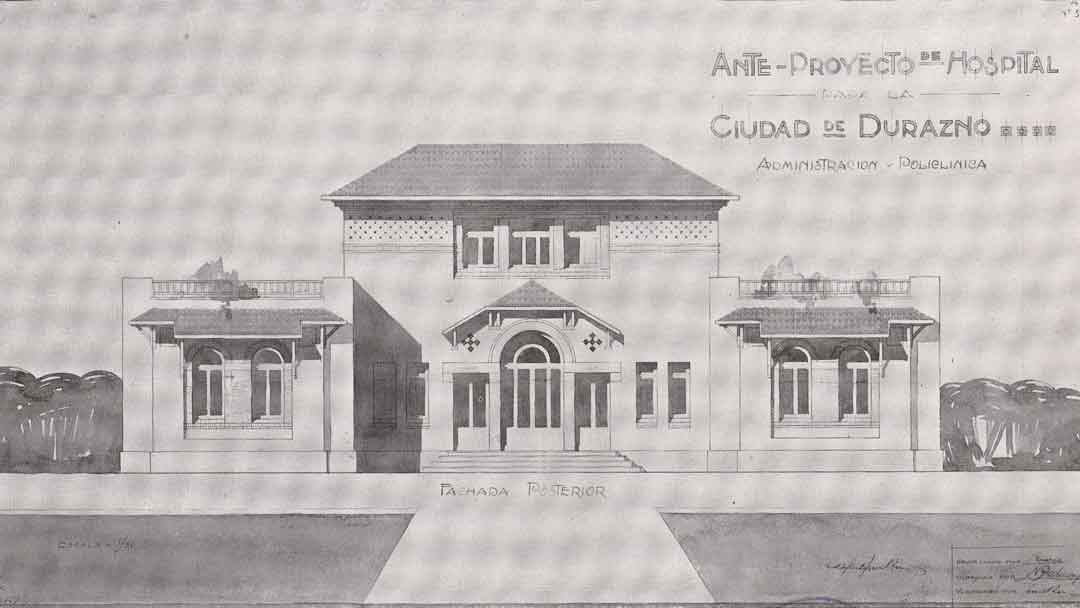Architecture, territory and governmentality
The case of public hospitals in the first decades of the 20th century in Uruguay
DOI:
https://doi.org/10.18861/ania.2021.11.2.3167Keywords:
State architecture, system of professions, territory, , governmentality, power, hospitalsAbstract
In the first decades of the country's independence, architecture did not exist as a modern profession and its knowledge was dispersed in various occupations and traditions. It is argued here that the process of professionalization in a national key is intimately associated with the centralized territorial control by the State that is consolidated after the last great civil war, in 1904. Likewise, both the architectural profession and the State are conceptualized as a process of continuous construction whose purpose is government (governmentality in Foucault's conception). In this sense, architecture offers the State a series of disciplinary tools that make up the sense of its professional jurisdiction and distinguish it from other knowledge and occupations.
The realization of public hospitals in the interior of the republic in the first decades of the 20th century shows all these processes and even more: it shows that the profession system is not only regulated by the jurisdictional struggle, but also has a significant degree of complementarity. Indeed, medicine and architecture were part of an alliance that was built as part of the same governmentality process carried out by the National Public Assistance from 1910.
Downloads
References
Fuentes Primarias
Armand Ugón, E. et alter, comps. (1930). Compilación de Leyes y Decretos, Tomo 18. Montevideo: Imprenta Nacional Colorada.
Burmester, C. (1894, enero) Agrimensura Legal. Anales de la Universidad, año III, Tomo V, pp. 500-562.
Asistencia Pública Nacional [APN] (1913). La Asistencia Pública Nacional. Montevideo: Talleres Gráficos A. Barreiro y Ramos.
APN (1922). Memoria de la Dirección General. Período 1916-1922. Montevideo: Talleres Gráficos A. Barreiro y Ramos.
Comisión Nacional de Caridad y Beneficencia Pública [CNCBP] (1907) Comisión Nacional de Caridad y Beneficencia Pública. Sus establecimientos y servicios en 1905. Montevideo: Talleres de la Escuela Nacional de Artes y Oficios.
Diario Oficial de la República Oriental del Uruguay (1905, setiembre 15), Tomo I, no. 3.
Jalabert, R. M.; Cabal, R. (1903). Álbum Biográfico Ilustrado. Buenos Aires: Talleres Heliográficos de Ortega y Radaelli.
La Colonia de Convalecientes (1921, mayo). Arquitectura [SAU], no. 43, pp. 56-58.
Ministerio de Obras Públicas [MOP] (1920). Contribución de la Sección Embellecimiento de Pueblos y Ciudades al Primer Congreso Pan Americano de Arquitectos celebrado en la ciudad de Montevideo. Montevideo.
Pérez Montero, C. (1927). Trabajo 4°, Tema XII. Actas y Trabajos. III Congreso Panamericano de Arquitectos. Buenos Aires, pp. 347-374.
Rossi, S. C. (1913). Proyecto de construcción y organización general de la Colonia Asilo de Alienados. Montevideo: Tipografía – Litografía Administración de Lotería.
Sociedad Ciencias y Artes (1879). Registro de ingenieros, arquitectos y maestros de obras. Boletín de la Sociedad Ciencias y Artes, año III, pp. 57-59 y 81-82.
Referencias bibliográficas
Abbott, Andrew (1988). The System of Professions. An Essay on the Division of Expert Labor. Chicago: The University of Chicago Press.
Barrán, J. P. (1992). Medicina y sociedad en el Uruguay del Novecientos. Tomo 1. El poder de curar. Montevideo: Ediciones de la Banda Oriental.
Barrán, J. P.; Nahum, B. (1973) Historia rural del Uruguay moderno. Tomo III. Recuperación y dependencia 1895-1904. Montevideo: Ediciones de la Banda Oriental.
Foucault, M. (2006). Seguridad, territorio, población. Curso en el Collège de France (1977-1978). Buenos Aires: Fondo de Cultura Económica.
Johnson, T. (2005). Governmentality and the institutionalization of expertise. En T. Johnson, G. Larkin y M. Saks (eds.) Health Professions and the State in Europe. Londres: Routledge, pp. 4-13.
Machado, C. (1972). Historia de los orientales. Montevideo: Ediciones de la Banda Oriental.
Mañé Garzón, F. (1992). En el centenario de los anales de la Universidad: 1881-1991. Cuadernos de Marcha. 3a. época, año VII, nro.68.
Mazzini, E.; Méndez, M. (2011). Polémicas de arquitectura en el Uruguay del siglo XX. Montevideo: CSIC-Udelar.
Nahum, B. (2003). Breve historia del Uruguay independiente. Montevideo: Ediciones de la Banda Oriental.
Pons, N. (1997). Apuntes de ayer. Hospitales y hospitalidad. Montevideo: Dos Puntos.
Rial, J.; Klaczko, J (1981). Uruguay: el país urbano. Montevideo: CLACSO, Ediciones de la Banda Oriental.
Ruiz, E. (1995). Estado e Ingenieros: una relación imprescindible en la formación del Uruguay moderno (1894-1905). Texto inédito.
Sierra Abbate, J. (2017). Asistencia Pública en el Uruguay hacia principios del siglo XX. Inicios de la arquitectura hospitalaria. Trabajo inédito presentado en la Maestría de Arquitectura de la FADU-Udelar.

Published
How to Cite
Issue
Section
License
Copyright (c) 2021 Santiago Medero

This work is licensed under a Creative Commons Attribution 4.0 International License.
The journal and its contents are licensed under the Creative Commons - Attribution 4.0 International License (CC BY 4.0). It is possible to copy, communicate and publicly distribute its content as long as the individual authors and the name of this publication are cited, as well as the publishing institution (Universidad ORT Uruguay).

